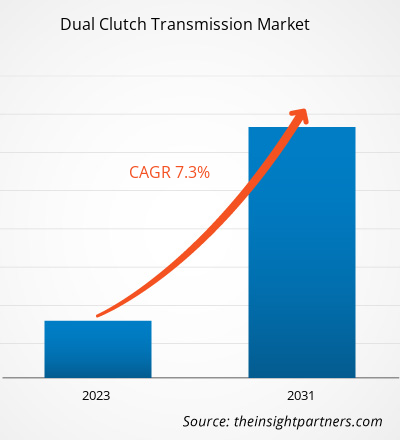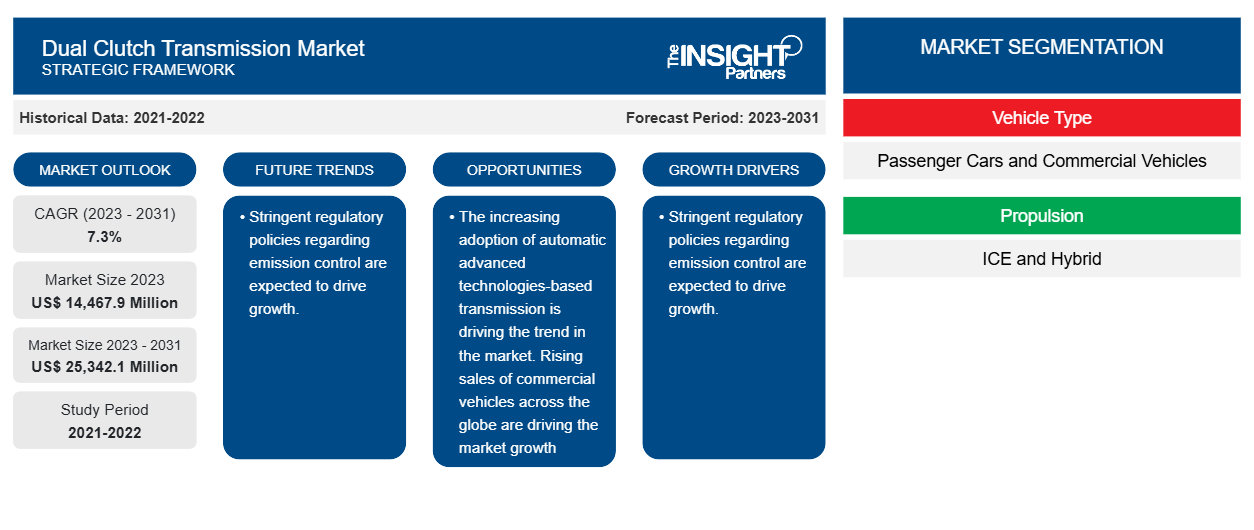من المتوقع أن يصل حجم سوق ناقل الحركة ثنائي القابض إلى 25.342.1 مليون دولار أمريكي بحلول عام 2031 من 14.467.9 مليون دولار أمريكي في عام 2023. ومن المتوقع أن يسجل السوق معدل نمو سنوي مركب بنسبة 7.3٪ خلال الفترة 2023-2031. إن التبني المتزايد لتقنيات ناقل الحركة الأوتوماتيكية المتقدمة يقود الاتجاه في السوق. كما أن ارتفاع مبيعات المركبات التجارية في جميع أنحاء العالم يقود نمو السوق.
تحليل سوق ناقل الحركة ثنائي القابض
يعتمد سوق ناقل الحركة ثنائي القابض ( DCT ) بشكل أساسي على زيادة مبيعات المركبات التجارية ومركبات الركاب في جميع أنحاء العالم. يحظى الطلب على ناقل الحركة ثنائي القابض بأكبر حصة في منطقة آسيا والمحيط الهادئ بسبب زيادة مبيعات المركبات في الهند والصين واليابان. في مركبات الركاب والمركبات التجارية، يستخدم ناقل الحركة ثنائي القابض قابضًا أوتوماتيكيًا لتحسين كفاءة الوقود وتقديم أداء عالٍ للمركبات. يستخدم ناقل الحركة ثنائي القابض لوحين للقابض يسمحان بالتغيير السريع للتروس دون أي تأخير في الإدخال.
نظرة عامة على سوق ناقل الحركة ثنائي القابض
ناقل الحركة ثنائي القابض ( DCT ) هو ناقل حركة يدوي آلي في المركبات التجارية ومركبات الركاب . يستخدم نظام ناقل الحركة هذا قابضين لضبط مجموعات التروس الفردية والزوجية. توفر تقنية ناقل الحركة ثنائي القابض ناقلي حركة يدويين. يوفر أحد المسارين التروس الأولى والثالثة والخامسة وربما السابعة للتغيير تلقائيًا، بينما يوفر المسار الآخر نسب تروس زوجية وناقل حركة عكسي. مع زيادة الطلب على تحسين كفاءة الوقود وأداء السيارة، يتم استخدام تقنية ناقل الحركة ثنائي القابض. توفر تقنية ناقل الحركة ثنائي القابض تغييرًا سلسًا للتروس وتوزيعًا فعالًا للطاقة للمركبات التجارية ومركبات الركاب.
قم بتخصيص هذا التقرير ليناسب متطلباتك
ستحصل على تخصيص لأي تقرير - مجانًا - بما في ذلك أجزاء من هذا التقرير، أو تحليل على مستوى الدولة، وحزمة بيانات Excel، بالإضافة إلى الاستفادة من العروض والخصومات الرائعة للشركات الناشئة والجامعات
-
احصل على أهم اتجاهات السوق الرئيسية لهذا التقرير.ستتضمن هذه العينة المجانية تحليلاً للبيانات، بدءًا من اتجاهات السوق وحتى التقديرات والتوقعات.
محركات وفرص سوق ناقل الحركة ثنائي القابض
ومن المتوقع أن تؤدي السياسات التنظيمية الصارمة المتعلقة بالسيطرة على الانبعاثات إلى تعزيز النمو.
في أمريكا الشمالية، من المتوقع أن تدفع مبادرات الحكومة والسياسات الفيدرالية والبرامج لمختلف الصناعات سوق الحافلات الكهربائية. وقعت الولايات المتحدة وكندا والمكسيك اتفاقية التجارة الحرة لأميركا الشمالية. ساعدت اتفاقية التجارة شركات صناعة السيارات في زيادة عدد مرافق التصنيع وتعزيز سلسلة التوريد لقطع غيار السيارات. تركز حكومة المكسيك بشكل كبير على جذب الاستثمار الأجنبي المباشر لتعزيز قطاع التصنيع في البلاد. تستثمر شركات صناعة السيارات مثل بي إم دبليو وأودي ومرسيدس في البلاد. ويرجع ذلك إلى المزايا الضريبية المختلفة بالإضافة إلى الواردات المعفاة من الرسوم الجمركية التي تقدمها حكومة المكسيك. أيضًا، لدى العديد من شركات تصنيع السيارات الأخرى قاعدة قائمة في البلاد.
تركز حكومات دول منطقة آسيا والمحيط الهادئ على تصنيع السيارات وبلدانها نفسها. على سبيل المثال، من خلال مبادرة صنع في الصين في عام 2025، تدعم حكومة الصين الشركات المحلية للتنافس مع شركات صناعة السيارات الأجنبية والتنافس عالميًا. علاوة على ذلك، توفر مبادرات الحكومة الهندية، مثل خطة مهمة السيارات 2016-26، الدعم الحكومي لصناعة تصنيع السيارات المتنامية في البلاد. لذلك، فإن هذه المبادرات الحكومية من شأنها أن تدعم نمو قطاع السيارات في المنطقة، مما سيدعم نمو سوق ناقل الحركة ثنائي القابض في منطقة آسيا والمحيط الهادئ .
من المتوقع أن يؤدي الاعتماد المتزايد على أنظمة القابض القائمة على التكنولوجيا المتقدمة إلى تعزيز نمو السوق
يتبنى اللاعبون الرئيسيون في السوق أنظمة نقل الحركة القائمة على التكنولوجيا المتقدمة لإطلاق نماذج جديدة من المركبات. على سبيل المثال، في أبريل 2024، أطلقت شركة Stellantis N.V. نظام نقل حركة كهربائي مزدوج القابض في إيطاليا. خططت الشركة لاستثمار حوالي 260 مليون دولار أمريكي لإنشاء صناعة السيارات الإيطالية في Mirafiori Automotive Park. كما أعلنت شركة Stellantis N.V. عن استثمار إضافي بقيمة 108 مليون دولار أمريكي لتعزيز إمكانات فيات 500e. ومن المتوقع أن يؤدي هذا الارتفاع في الاستثمار وإطلاق تطوير أنظمة DCT الجديدة من قبل اللاعبين الرئيسيين إلى خلق فرصة كبيرة لنمو السوق.
تقرير تحليلي لتجزئة سوق ناقل الحركة ثنائي القابض
إن القطاعات الرئيسية التي ساهمت في اشتقاق تحليل سوق ناقل الحركة ثنائي القابض هي نوع السيارة، والدفع، وفئة السيارة، والجغرافيا.
- بناءً على نوع السيارة، ينقسم السوق إلى سيارات ركاب ومركبات تجارية. ومن بين هذه السيارات، كانت سيارات الركاب هي النصيب الأكبر في عام 2023. ويرجع هذا إلى زيادة مبيعات سيارات الركاب في جميع أنحاء العالم.
- اعتمادًا على الدفع، ينقسم السوق إلى محركات الاحتراق الداخلي والهجينة. ومن بين هذه المحركات، كان لمحركات الاحتراق الداخلي الحصة الأكبر في عام 2023. ويرجع هذا إلى زيادة مبيعات المركبات في جميع أنحاء العالم. ووفقًا لوكالة الطاقة الدولية، ارتفعت مبيعات السيارات العالمية إلى 92.72 مليون وحدة في عام 2022 من 82.8 مليون وحدة مقارنة بعام 2021.
- اعتمادًا على فئة السيارة، يتم تقسيم السوق إلى A/B وC وD وE وما فوق، وSUV والتروس الأمامية (6 و7 و8 وما فوق). ومن بين هذه، تتمتع SUV بالحصة الأكبر بسبب زيادة اعتماد DCT في سيارات SUV.
تحليل حصة سوق ناقل الحركة ثنائي القابض حسب المنطقة الجغرافية
ينقسم النطاق الجغرافي لتقرير سوق ناقل الحركة ثنائي القابض بشكل أساسي إلى خمس مناطق: أمريكا الشمالية، وآسيا والمحيط الهادئ، وأوروبا، والشرق الأوسط وأفريقيا، وأمريكا الجنوبية والوسطى.
من المتوقع أن تحظى منطقة آسيا والمحيط الهادئ بأكبر حصة في سوق ناقل الحركة ثنائي القابض بسبب زيادة الطلب ومبيعات السيارات في البلدان النامية مثل الصين والهند واليابان. في عام 2023، وفقًا لجمعية مصنعي السيارات الصينية، تم بيع حوالي 26 مليون وحدة من سيارات الركاب في الصين. احتلت الهند المرتبة الثانية من حيث الحجم في منطقة آسيا والمحيط الهادئ. هذه العوامل مسؤولة عن نمو سوق ناقل الحركة ثنائي القابض خلال الفترة المتوقعة.
رؤى إقليمية حول سوق ناقل الحركة ثنائي القابض
لقد قام المحللون في Insight Partners بشرح الاتجاهات والعوامل الإقليمية المؤثرة على سوق ناقل الحركة ثنائي القابض طوال فترة التوقعات بشكل شامل. يناقش هذا القسم أيضًا قطاعات سوق ناقل الحركة ثنائي القابض والجغرافيا في جميع أنحاء أمريكا الشمالية وأوروبا ومنطقة آسيا والمحيط الهادئ والشرق الأوسط وأفريقيا وأمريكا الجنوبية والوسطى.

- احصل على البيانات الإقليمية المحددة لسوق ناقل الحركة ثنائي القابض
نطاق تقرير سوق ناقل الحركة ثنائي القابض
| سمة التقرير | تفاصيل |
|---|---|
| حجم السوق في عام 2023 | 14,467.9 مليون دولار أمريكي |
| حجم السوق بحلول عام 2031 | 25,342.1 مليون دولار أمريكي |
| معدل النمو السنوي المركب العالمي (2023 - 2031) | 7.3% |
| البيانات التاريخية | 2021-2022 |
| فترة التنبؤ | 2023-2031 |
| القطاعات المغطاة |
حسب نوع السيارة
|
| المناطق والدول المغطاة |
أمريكا الشمالية
|
| قادة السوق وملفات تعريف الشركات الرئيسية |
|
كثافة اللاعبين في السوق: فهم تأثيرها على ديناميكيات الأعمال
يشهد سوق ناقل الحركة ثنائي القابض نموًا سريعًا، مدفوعًا بالطلب المتزايد من المستخدم النهائي بسبب عوامل مثل تفضيلات المستهلك المتطورة والتقدم التكنولوجي والوعي المتزايد بفوائد المنتج. ومع ارتفاع الطلب، تعمل الشركات على توسيع عروضها والابتكار لتلبية احتياجات المستهلكين والاستفادة من الاتجاهات الناشئة، مما يؤدي إلى زيادة نمو السوق.
تشير كثافة اللاعبين في السوق إلى توزيع الشركات أو المؤسسات العاملة في سوق أو صناعة معينة. وهي تشير إلى عدد المنافسين (اللاعبين في السوق) الموجودين في مساحة سوق معينة نسبة إلى حجمها أو قيمتها السوقية الإجمالية.
الشركات الرئيسية العاملة في سوق ناقل الحركة ثنائي القابض هي:
- ماجنا الدولية المحدودة
- شركة شايفلر للتكنولوجيا ايه جي وشركاه
- شركة بورجوارنر
- شركة دايملر ايه جي
- شركة فولكس فاجن ايه جي
- شركة ZF فريدريشهافن ايه جي
إخلاء المسؤولية : الشركات المذكورة أعلاه ليست مرتبة بأي ترتيب معين.

- احصل على نظرة عامة على أهم اللاعبين الرئيسيين في سوق ناقل الحركة ثنائي القابض
أخبار سوق ناقل الحركة ثنائي القابض والتطورات الأخيرة
يتم تقييم سوق ناقل الحركة ثنائي القابض من خلال جمع البيانات النوعية والكمية بعد البحث الأولي والثانوي، والتي تتضمن منشورات الشركات المهمة وبيانات الجمعيات وقواعد البيانات. فيما يلي بعض التطورات في سوق ناقل الحركة ثنائي القابض:
- أطلقت شركة Punch Powertrain نظام DCT المبتكر بتصميم ثوري أكثر إحكاما وبأسعار معقولة. تم إطلاق DT1 في الهند، حيث ظهر لأول مرة في الإطلاق الأخير لـ Altroz DCA بواسطة Tata Motors. (المصدر: موقع الشركة، مارس 2022)
- تعتزم شركة تاتا أوتوكومب استثمار 500 كرور روبية في مصنع ناقل الحركة ثنائي القابض في تشاكان. بهدف تلبية الطلب المتزايد على السيارات المجهزة بناقل حركة أوتوماتيكي في الهند، تتطلع شركة تاتا أوتوكومب إلى تحقيق ميزة كونها الأولى في هذا المجال حيث تستعد لإنشاء مصنع جديد بسعة إنتاج أولية تبلغ 100 ألف وحدة. (المصدر: بيان صحفي، يناير 2023)
تقرير سوق ناقل الحركة ثنائي القابض: التغطية والنتائج المتوقعة
يوفر تقرير "حجم سوق ناقل الحركة المزدوج والتوقعات (2021-2031)" تحليلاً مفصلاً للسوق يغطي المجالات التالية:
- حجم سوق ناقل الحركة ثنائي القابض والتوقعات على المستويات العالمية والإقليمية والوطنية لجميع قطاعات السوق الرئيسية التي يغطيها النطاق
- اتجاهات سوق ناقل الحركة ثنائي القابض بالإضافة إلى ديناميكيات السوق مثل السائقين والمقيدات والفرص الرئيسية
- تحليل مفصل لـ PEST و SWOT
- تحليل سوق ناقل الحركة ثنائي القابض يغطي اتجاهات السوق الرئيسية والإطار العالمي والإقليمي واللاعبين الرئيسيين واللوائح والتطورات الأخيرة في السوق
- تحليل المشهد الصناعي والمنافسة الذي يغطي تركيز السوق، وتحليل خريطة الحرارة، واللاعبين البارزين، والتطورات الأخيرة لسوق ناقل الحركة ثنائي القابض
- ملفات تعريف الشركة التفصيلية
- التحليل التاريخي (سنتان)، سنة الأساس، التوقعات (7 سنوات) مع معدل النمو السنوي المركب
- تحليل PEST و SWOT
- حجم السوق والقيمة / الحجم - عالمي، إقليمي، بلد
- الصناعة والمنافسة
- مجموعة بيانات إكسل
التقارير الحديثة
شهادات العملاء
سبب الشراء
- اتخاذ قرارات مدروسة
- فهم ديناميكيات السوق
- تحليل المنافسة
- رؤى العملاء
- توقعات السوق
- تخفيف المخاطر
- التخطيط الاستراتيجي
- مبررات الاستثمار
- تحديد الأسواق الناشئة
- تحسين استراتيجيات التسويق
- تعزيز الكفاءة التشغيلية
- مواكبة التوجهات التنظيمية























 احصل على عينة مجانية ل - سوق ناقل الحركة ثنائي القابض
احصل على عينة مجانية ل - سوق ناقل الحركة ثنائي القابض